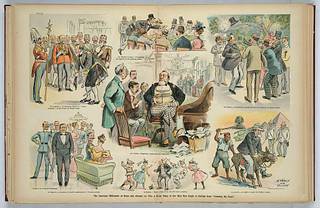
Similar
The American millionaire at home and abroad; or, why a great many of our rich men ought to refrain from "crossing the pond" / F. Opper and Ehrhart.
Summary
Print shows a vignette cartoon showing a dignified and respected millionaire in familiar surroundings at home; and while traveling through major European cities, he is ignored, ridiculed, laughed at as the butt of practical jokes, and sometimes prone to boorish behavior at the gaming tables in Monte Carlo.
Illus. from Puck, v. 41, no. 1053, (1897 May 12), centerfold.
Copyright 1897 by Keppler & Schwarzmann.
Alois Senefelder, the inventor of lithography, introduced the subject of colored lithography in 1818. Printers in other countries, such as France and England, were also started producing color prints. The first American chromolithograph—a portrait of Reverend F. W. P. Greenwood—was created by William Sharp in 1840. Chromolithographs became so popular in American culture that the era has been labeled as "chromo civilization". During the Victorian times, chromolithographs populated children's and fine arts publications, as well as advertising art, in trade cards, labels, and posters. They were also used for advertisements, popular prints, and medical or scientific books.
Tags
Date
Contributors
Source
Copyright info







![Belleau Woods. Americans and their captives--A few who escaped the bayonnettes [sic] Belleau Woods. Americans and their captives--A few who escaped the bayonnettes [sic]](https://cache.getarchive.net/Prod/thumb/cdn18/L3Bob3RvLzIwMTkvMTEvMDcvYmVsbGVhdS13b29kcy1hbWVyaWNhbnMtYW5kLXRoZWlyLWNhcHRpdmVzLWEtZmV3LXdoby1lc2NhcGVkLXRoZS1iYXlvbm5ldHRlcy05OTA1MjctNjQwLmpwZw%3D%3D/40/31/jpg)



























